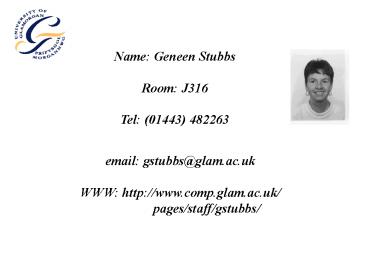First Setfy lecture - PowerPoint PPT Presentation
1 / 22
Title:
First Setfy lecture
Description:
The monitor is also called the Visual Display Unit or VDU. The user looks at the screen to see what the ... Magnetic Tape - comes on a reel or cartridge; ... – PowerPoint PPT presentation
Number of Views:33
Avg rating:3.0/5.0
Title: First Setfy lecture
1
Name Geneen Stubbs Room J316 Tel (01443)
482263
email gstubbs_at_glam.ac.uk WWW
http//www.comp.glam.ac.uk/
pages/staff/gstubbs/
2
Overview
- Hardware
- Primary Components
- Input Devices
- CPU
- Output Devices
- Secondary Storage Devices
- Software
- Applications Software
- Programs
3
The Computer
Monitor
System Unit
Speaker
Mouse
Keyboard
4
Hardware
The equipment associated with a computer system
- The Monitor
- The Keyboard
- The Mouse
- The Systems Unit
- The Printer
5
The Monitor
The monitor is also called the Visual Display
Unit or VDU. The user looks at the screen to see
what the computer is doing.
6
The Keyboard
The keyboard is the tool you use to communicate
with the computer. You use the keyboard to type
in the information that you want to store in the
computer and also to type in commands to run
programs.
7
The Mouse
Right Mouse Button
Left Mouse Button
Top
Underneath
As you roll the mouse around on your desk, a
small arrow called a mouse pointer or cursor
moves around the computer screen in the same
direction as you roll the mouse.
8
The System Unit
The system unit is the computer proper. The
keyboard, monitor, mouse and printer all,
generally, plug into the back of this unit. The
system unit houses the disk drives, central
processing unit (CPU) and memory.
9
The Printer
- The printer provides you with a printed hard
copy of - what you see on the screen
- documents you have created
- letters or reports
- graphics etc.
10
The Printer contd
- There are several types of printer available to
you. These include - dot-matrix printers
- ink-jet printers
- laser printers
- and all these printers can be either black and
white or colour.
11
Primary Components of a Computer
Input Devices - accept data in a form the
computer can use The Central Processing Unit
(CPU) - has the electronic circuitry for
manipulating data into the information
required Memory - temporarily holds data and
instructions needed by the CPU Output Devices -
make the processed data available for
use Secondary Storage Devices - store additional
data and programs.
12
Input Devices
- Keyboard
- Mouse
- Trackball
- Joystick
- Light Pen
- Scanner, Bar Code Reader
- Voice Input System.
13
CPU
Types of CPU- Motorola 680X0 - used in
Macintosh Computers e.g. 68020, 68030 etc. Intel
80X86 - used in IBM-compatible machines (PCs)
e.g. 80286, 80386, 80486 etc. currently Pentium
chips equivalent to 80586 and the next version
will be Pentium Pro.
14
Memory
- RAM - Random Access Memory
- ROM - Read-Only Memory.
- This type of memory is known as primary storage.
15
Output Devices
- Monitors
- Printers.
16
Secondary Storage Devices
- Hard Drive - additional storage separate from
the CPU and memory - Floppy Disk - oxide-coated disk
- Magnetic Tape - comes on a reel or cartridge
- CD-ROM - compact disk read-only memory optical
storage.
17
Bits, binary digits, are used to store items in
the computers memory. Each bit has one of only
two possible values 0 or 1.
00012 110 00102 210 00112 310 11112
1510 10000000002 102410
18
A byte, is a group of eight bits.
C 01000011 (Decimal 67) ! 00100001 (Decimal
33) 00101010 (Decimal 42) 128 64 32 16 8
4 2 1 0 1 0 0 0 0 0 0 64
19
- Software
Software consists of the instructions that tell a
computer what to do.
- Applications Software
Software that is used to solve a
particular problem.
- Program
Set of step-by-step instructions that directs the
computer.
20
Applications Software
- Word processing / desktop publishing
- Electronic spreadsheets
- Database management programs
- Graphics packages
- Data communications
21
Program
A Program can be written in a variety of
programming languages. Higher level languages are
more like natural language, while low level
languages are closer to machine code.
22
Suggested Reading
Your First Computer - Second Edition by Alan
Simpson. Computer Science - 4th Edition by C. S.
French































